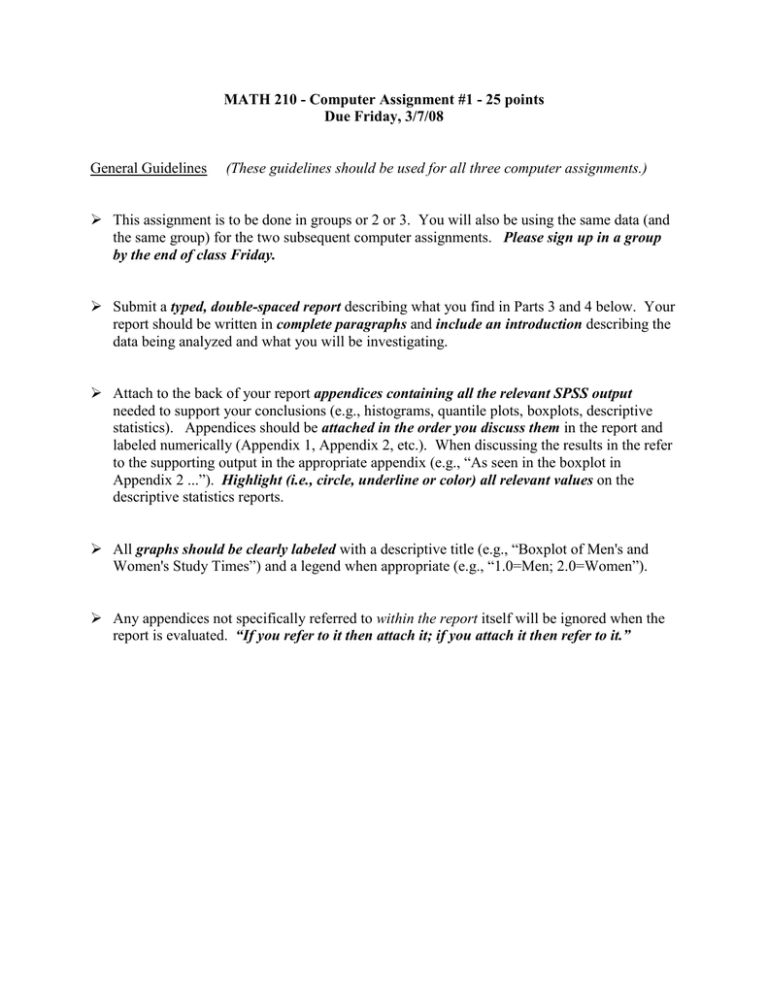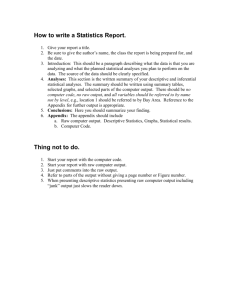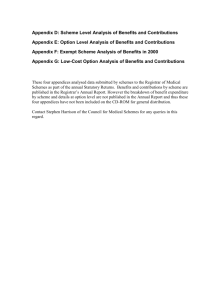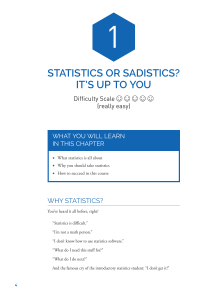Computer Assignment #1
advertisement

MATH 210 - Computer Assignment #1 - 25 points Due Friday, 3/7/08 General Guidelines (These guidelines should be used for all three computer assignments.) This assignment is to be done in groups or 2 or 3. You will also be using the same data (and the same group) for the two subsequent computer assignments. Please sign up in a group by the end of class Friday. Submit a typed, double-spaced report describing what you find in Parts 3 and 4 below. Your report should be written in complete paragraphs and include an introduction describing the data being analyzed and what you will be investigating. Attach to the back of your report appendices containing all the relevant SPSS output needed to support your conclusions (e.g., histograms, quantile plots, boxplots, descriptive statistics). Appendices should be attached in the order you discuss them in the report and labeled numerically (Appendix 1, Appendix 2, etc.). When discussing the results in the refer to the supporting output in the appropriate appendix (e.g., “As seen in the boxplot in Appendix 2 ...”). Highlight (i.e., circle, underline or color) all relevant values on the descriptive statistics reports. All graphs should be clearly labeled with a descriptive title (e.g., “Boxplot of Men's and Women's Study Times”) and a legend when appropriate (e.g., “1.0=Men; 2.0=Women”). Any appendices not specifically referred to within the report itself will be ignored when the report is evaluated. “If you refer to it then attach it; if you attach it then refer to it.” Assignment Description 1. Download the CSDATA database from the course web pages and read the background material provided in the data appendix (p. D-2) of the text book (IPS). 2. Use SPSS to randomly select 100 of the 224 cases as follows: a. Reset the random number generator by selecting: Transform Random Number Generators Set Starting Point Fixed value <enter your student ID number> b. Now select 100 cases as follows: Data Select Cases Random Sample of Cases Exactly 100 Cases from the first 224 SPSS has “filtered out” all observations having a 0 in the filter_$ column, marking them with a slash in the left-hand margin. These rows will automatically be ignored for the purposes of your analysis. (Since each person used a different starting point in the random number generator everyone will have a different sample of 100 students.) Save the data file to something like MyCSData. Note that if you later reopen MyCSData the slashes have all disappeared (i.e., your sample of 100 has no longer been selected). To limit your work to just the 100 people previously chosen you can either repeat steps (a) and (b) above or follow: Data Select Cases If condition is satisfied In the upper right window type: filter_$=1 3. For each of the numerical variables HSM, HSE, SATM, and SATV (we will ignore GPA and HSS) construct a histogram and normal quantile plot. Describe the distributions of each of these variables (e.g., overall range, most commonly observed range of values, symmetry/skewness, peaks, and outliers). Be as detailed as possible, using the output to support your answers. 4. For each of the four numerical variables create a side-by-side boxplot comparing male and female students. (That is, compare male to female HSM, then male to female HSE, etc.). For each variable how do males compares to females in terms of center and variation? (Specifically compare the means, medians, quartiles, IQRs and standard deviations for the male versus female data, using the descriptive statistics and percentile reports to support your answers.) Does the data seem to support traditional stereotypes of males being stronger at math and females at English? Which of these four variables seem to most clearly exhibit a difference between males and females?


